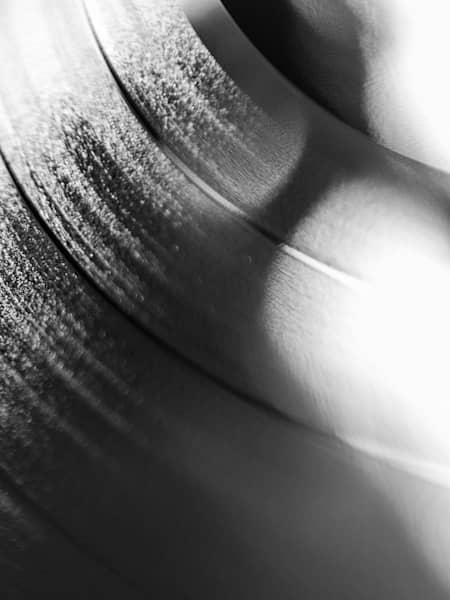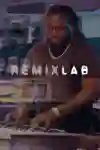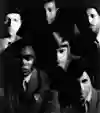If you’ve ever enjoyed a top-100 record in the past 35 years or so, then you owe some thanks to a French composer who obsessively messed with rudimentary sound tech while wearing ill-fitting suits. In the 1940s, Pierre Schaeffer was splicing together bits of recorded material, crafting what would become musique concrète. These absurd sound montages were, to most people, completely unlistenable, but his revolutionary technique formed the primitive origins of sampling.
If you’ve been living under a rock, let us explain: sampling is the art of taking one part of an existing track and, by looping it, turning it into a new one. But also, it’s much more than that. A 5.2 second snippet from The Winstons’ Amen, Brother actually birthed a new genre when its “amen break”, performed by Gregory Coleman, became the bedrock of drum ’n’ bass; and by taking the bassline from Chic’s Good Times, The Sugarhill Gang created a foundation-laying hip-hop record with Rapper’s Delight.
The influence of sampling on modern music can't be understated, but the road towards releasing a record featuring one was (and still can be) rocky. Originating in its modern form in the ’70s, sampling was an abstract concept to major labels who interpreted it as stealing. But for broke hip-hop producers attempting to emulate Grandmaster Flash, sampling was a quick, easy and (crucially) cheap way to make beats.
Still, labels demanded money for using their music – a hilariously unachievable notion to the average basement-dwelling producer in late ’70s and early ’80s NYC. The inherent financial risk in this was also huge, and so those producers who could afford to pay chose to sample already established records to better guarantee a hit.
Many hip-hop producers took samples on a “use first, worry later” basis, and this wasn't without its problems. Beastie Boys are still paying for their 1989 homage to ‘70s funk, Paul’s Boutique. A relative flop at the time, the album has become a blueprint for creative sampling, containing anything from 100 to 300 musical excerpts. In July, 2019, the album’s recording engineer, Mario Caldato Jr, recalled how over US$250,000/€227,000/£195,000 was spent on legal clearances, and that “the list of samples on the album is so long – they [Paul’s Boutique producers The Dust Brothers] are still getting sued over it.” On the flip side, The Winstons received very little for the use of their Amen, Brother break in thousands of tracks. Only a 2015 GoFundMe campaign ensured that surviving member Richard L Spencer got any money.
Watch hip-hop producer Wheezy at work in Remix Lab.

16 min
Wheezy
Producer Wheezy reveals some of his secret sauce, like his go-to hi-hats and kicks.
“When sampling was first used, very little was cleared,” says Rob Shanks, who, as head of copyright and business affairs for Ninja Tune and its publishing arm Just Isn’t Music, makes sure all samples used are done so legitimately. “This resulted in many lawsuits,” he adds.
One of those lawsuits hit Biz Markie in 1991, when Warner Bros. pulled copies of his album I Need A Haircut after the single Alone Again unlawfully looped Gilbert O’Sullivan’s Alone Again (Naturally), while Beastie Boys also found themselves in trouble, pre-Paul’s Boutique, with the track Hold It Now, Hit It. In 1987, they were sued by Jimmy Castor over the phrase “Yo, Leroy”, which was taken from Castor’s 1977 song The Return of Leroy Part 1.
Arguably the biggest dispute in hip-hop history came when a 12-second audio clip pitted De La Soul against wholesome US band The Turtles. Transmitting Live From Mars, a skit from De La Soul’s Daisy Age masterpiece 3 Feet High And Rising, sampled The Turtles' 1969 song You Showed Me without securing proper clearance, resulting in a lawsuit that proved costly for De La Soul. "Sampling is just a longer term for theft," Turtles member Howard Kaylan told the Los Angeles Times. "Anybody who can honestly say sampling is some sort of creativity has never done anything creative."
“Despite this,” Shanks explains, “the culture of not clearing samples seemed to prosper.” While major labels were trying to make an example of hip-hop producers, music execs were still trying to understand what sampling actually was. There were no legal guidelines on what constituted a “sample”. Even major publications couldn’t decipher what was happening. In 1989, the Los Angeles Times asked if sampling was a Creative Tool or License to Steal?.
The kids weren’t put off, though, and producers were making records faster than lawyers could keep up as white label records became widespread on both sides of the Atlantic. These uncredited records used samples but contained zero information about its makers. As producers became untraceable, so they began influencing a philosophical shift. As the culture grew, people began to understand that sampling wasn’t (just) stealing – it was reincarnating.
This lead to a renaissance period from the mid ’90s and into the 2000s, and records like Since I Left You by The Avalanches and DJ Shadow’s Endtroducing...... In 2006 came J Dilla’s Donuts, from Stones Throw Records. Released on Dilla’s 32nd birthday, and three days before his death, Donuts is now rightfully recognised as a masterpiece. “With Donuts, the idea wasn't to make a successful record, it was to show people that Dilla was still making music,” recalls Egon, speaking over the phone from Los Angeles. As Stones Throw Records’ general manager from 2000 until 2011, Egon’s job was to take Donuts from the studio to the shelves.
Excerpts from tracks by major artists such as The Jackson 5, Mantronix, Frank Zappa and 10cc all feature on Donuts, but this monumentally ambitious record was made possible through a series of “handshake agreements with a couple of people,” recalls Egon. “We weren't working to clear samples at the time, we were working to get a record out in the most economical and efficient way possible.”
As the founder of reissue label Now-Again Records, Egon’s own musical catalogue has been sampled by everyone from Christina Aguilera and Caribou to Beyoncé, who found the beat for 2016’s Freedom in a little-known psych-rock track by Puerto Rican band Kaleidoscope. Sampling took time to reach these heights, says Egon. For years, it was stifled by the idea it lacked creativity. But Egon points to acts like Kanye West, Pharrell, Just Blaze and DJ Premier, who elevated the art-form to the upper echelons of pop.
“Hip-hop has changed a lot and we’ve got to a point where samples in mainstream hip-hop are an acceptable proposition again,” thinks Egon. “From the sampled producers to the managers, lawyers and publishers, today people realise there's a good distance in this for everyone, provided it's easy and it's ethical for everybody.”
What Egon is getting at is money – if everyone is getting paid, then everyone is happy. But for those without Beyoncé's means, how does a producer navigate the minefield of licensing a sample and releasing a record?
“Research,” begins Shanks, describing the first of his four-part process to clearing a sample. “Find out who owns the rights to the sample you’re using. Then it's contact – once you’ve found the owners, get in touch with them. It can take time to get to a specific person, but if you find a licensing contact, that should be a good start.”
From there, you negotiate. “Once you’ve confirmed the owners [of the sample], make sure to get in writing that they control all the rights you need and that they can license such rights to you. Then you need to discuss a deal.” Then, finally, you can release your track.
Shanks makes it sound easy, but licensing remains a complex and sometimes expensive endeavour. With that said, could a record like Paul’s Boutique or Donuts be made today? Egon points to the recent MadGibbs (Freddie Gibbs and Madlib) collaborative album Bandana, released on Egon’s co-partnered label Madlib Invazion, Keep Cool and RCA. From the transcendental elevator jazz of Walt Barr’s Free Spirit to the ragga callout sourced from Super Beagle's Dust A Sound Boy, dozens of samples appear in Bandana.
With so many sonic elements, Egon, who was still approving rights until the week of release, took seven or eight months to finalise clearances at a licensing cost of – and this is a tentative estimate – US$100,000/€91,000/£78,000. “Bandana is not the Paul’s Boutique of 2019,” he says. “But it is an example of how, in 2019, you can create an album [like Paul’s Boutique]. If you have everything lined up and you don't take a passive approach, you can go out and figure it out.”
“I look at copyright as something that's not to be jealously protected, but rather to be shared, enjoyed and distributed among people who have a reason to find new opportunities for it,” Egon adds. “That's everything. That's fostering the creation of art, so I look at this as a long-term gain. What is going to incentivise people to want to do this further down the line?"
Today, sampling has morphed into a different entity. “In the last decade, producers have been using samples in more creative ways, adding to the original track instead of being the basis of it,” believes Shanks. With the world’s discography available on YouTube, sampling has become a looser term, with Kanye West sourcing audio from a viral video of a child preacher for Life Of Pablo’s opening track Ultralight Beam. Since then, he was reportedly sued by the toddler’s parents for illegal use of the recording, but the sentiment remains.
To artists like Teebs, the Brainfeeder-signed alias of Mtendere Mandowa, sampling is almost a cathartic exercise. “A sample has to meet a criteria. This changes depending if it’s something I want to release, what mood I’m in, and what I want to hear in my house,” he says. “I tend to let the sounds I record loop all day and see how, with time, the sounds make me feel. Some could be great at first, but then you begin to feel out the problems with them and decide if you continue to work with it or not. It’s like building a relationship.”
On his debut album Ardour, Teebs stretched, warped and distorted old material into vast soundscapes that resonate in blissful frequencies. Anicca, Teebs's latest album, steers away from those origins. The sparse samples he uses on it are like a secondary instrument, a little like faint backing vocals that give way to his collaborators, including Panda Bear and Sudan Archives. “[On Anicca] I tried my hand at using some instruments I always found interesting,” says Mandowa. “I wanted to get closer to the East African music I heard growing up, and make a record that I could see my daughter listening to in 10 years time.”
But Anicca still owes its existence to Mandowa’s early years chopping and looping snippets of old records in his bedroom, something that started as a happy accident. “I remember opening up [music software] FL Studio, and I accidentally dragged a whole album from a rapper named Circus into the program,” he recalls. “My computer froze for a day, but when I returned the entire album was chopped into split second sound bites. All of a sudden, I had sounds I’d never heard before, and in those strange unorganised chops there was magic that was once unnoticed.”
Perhaps that's why sampling conjures new ideas – ones that inspire French experimentalists and bedroom producers alike. Says Mandowa: “Sampling is a form of expression that can go as deep as your imagination can carry you."












